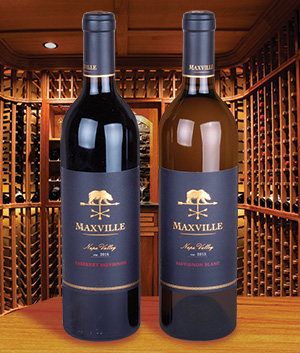 Mad Max(ville)
Mad Max(ville)
The 1000-acre Maxville Winery’s Napa Valley estate is located in the Chiles Valley AVA, in the Vaca Mountains, running parallel to and northeast of the Silverado Trail. The property was first planted to grape vines in 1974; today Maxville has over 100 acres of vineyard located at elevations between 900 and 1,200 feet. The volcanic soils provide a prime growing condition for wines, and Maxville practices sustainable dry farming methods in order to preserve the integrity of the property.
With a cooler microclimate than the main Napa Valley floor, afternoons are still sunny and warm, but nighttime temperatures plunge. This encourages full phenolic maturity, giving the grapes the potential of tremendous complexity.
In 1996, a new tasting room and barrel ageing facility was built, and it was extensively remodeled in 2016.
Under the owners that acquired the property in 2014, Executive Winemaker Camille Benitah began an extensive redevelopment and restoration of both the vineyards and the riparian corridors. “The Chiles Valley is real and rural and absolutely awe-inspiring,” says Benitah. “This is really an undiscovered part of the Napa Valley – it has so much history, but it’s also still pristine.”
Maxville Sauvignon Blanc 2014
This pale straw-colored wine is made from 100% estate-grown Musqué clone grapes. The nose expresses aromas of lemon cream and guava. The lemon notes continue on the palate, supported by by citrus and pear flavors. The acidity is well-integrated, and the finish is full-bodied and long.
Unusually, the wine was then aged three ways using a concrete egg, stainless steel, and barrels. The components were aged sur lies for eight-months before blending and bottling.
Although delicious now, this Sauvignon Blanc could last up to 10 years in the cellar, if you can wait that long. Not me.
Pair this selection with shellfish and potatoes à la Marinière, butter-poached lobster with tarragon and champagne, or grilled scallops with Rémoulade sauce.
Maxville Cabernet Sauvignon 2014
This Cabernet presents with a deep garnet hue and aromas of cedar and dark fruit. The flavor is fruit-forward, dominated by blackberry, cassis, and currant, supported by hints of chocolate, spice, and toasted oak. It’s all wrapped up with tightly wound tannins, zippy acidity and a long full finish. Decant (for at least two hours) now to make the aromatics more accessible, or let it rest for up to 15 years if you like a softer character.
This Cab underwent a seven-day cold-soak followed by a warm fermentation. The wine was left on skins for one week after primary fermentation finished. Malolactic fermentation was done in barrel; spending 18 months in 60% new French oak barrels.
This wine yearns for robust dishes like Bistecca alla Fiorentina; Provençal rack of lamb; or spit-roasted piri-piri chicken.
Back to blog posts: winervana.com/blog/
